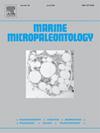The biostratigraphy and palaeobiogeography of the Late Jurassic dinoflagellate cysts from the Binalud Mountains, NE Iran
IF 1.5
4区 地球科学
Q2 PALEONTOLOGY
引用次数: 0
Abstract
This study investigates the dinoflagellate cysts from the upper part of the Dalichai Formation in the Binalud Mountains (NE Iran, western Tethys), where the deposits are primarily consist of shale and marlstone layers. The analyzed section yielded common and diverse dinoflagellate cyst assemblages comprising 46 species belonging to 33 genera. These assemblages are correlated with the DSJ24–DSJ33 dinoflagellate cyst Zones of the Late Jurassic (late Oxfordian–Tithonian) in the Northern Hemisphere. Key bioevents identified in this interval included the last occurrences of Compositosphaeridium polonicum in the late Oxfordian, the last occurrence of Ctenidodinium ornatum at the Oxfordian–Kimmeridgian boundary, the last occurrences of Tubotuberella eisenackii and Scriniodinium crystallinum in the early Kimmeridgian, and the last occurrence Endoscrinium luridum around the Kimmeridgian–Tithonian boundary. The dinoflagellate cyst assemblages exhibit strong similarities to the flora of the western Tethys (the Middle East, Europe, eastern North America, and North Africa) and are marked differences from coeval assemblages of the eastern Tethys (Australasia, eastern Asia, and northeastern India), reflecting significant provincialism between the western and eastern Tethys during the Late Jurassic.
伊朗东北部比纳鲁德山脉晚侏罗世甲藻囊的生物地层学和古生物地理
本文研究了伊朗东北部特提斯西部比纳鲁德山脉达利柴组上部的鞭毛藻囊,该矿床主要由页岩和泥灰岩层组成。所分析的剖面产生了常见和多样的鞭毛藻囊组合,包括33属46种。这些组合与北半球晚侏罗世(晚牛津—晚铁桑世)dsj24—dsj33鞭毛藻囊带具有相关性。在这段时间内鉴定出的主要生物事件包括复合osphaeridium polonicum最后一次出现在牛津纪晚期,Ctenidodinium ornatum最后一次出现在牛津纪与kimmerid纪交界,Tubotuberella eisenackii和Scriniodinium crystallinum最后一次出现在kimmerid纪早期,Endoscrinium luridum最后一次出现在kimmerid纪与tithonian交界。鞭毛藻囊群与特提斯西部(中东、欧洲、北美东部和北非)的植物群具有很强的相似性,而与特提斯东部(澳大利亚、东亚和印度东北部)的同期植物群有显著差异,反映了晚侏罗世特提斯西部和东部之间的显著地方性差异。
本文章由计算机程序翻译,如有差异,请以英文原文为准。
求助全文
约1分钟内获得全文
求助全文
来源期刊

Marine Micropaleontology
地学-古生物学
CiteScore
3.70
自引率
15.80%
发文量
62
审稿时长
26.7 weeks
期刊介绍:
Marine Micropaleontology is an international journal publishing original, innovative and significant scientific papers in all fields related to marine microfossils, including ecology and paleoecology, biology and paleobiology, paleoceanography and paleoclimatology, environmental monitoring, taphonomy, evolution and molecular phylogeny. The journal strongly encourages the publication of articles in which marine microfossils and/or their chemical composition are used to solve fundamental geological, environmental and biological problems. However, it does not publish purely stratigraphic or taxonomic papers. In Marine Micropaleontology, a special section is dedicated to short papers on new methods and protocols using marine microfossils. We solicit special issues on hot topics in marine micropaleontology and review articles on timely subjects.
 求助内容:
求助内容: 应助结果提醒方式:
应助结果提醒方式:


